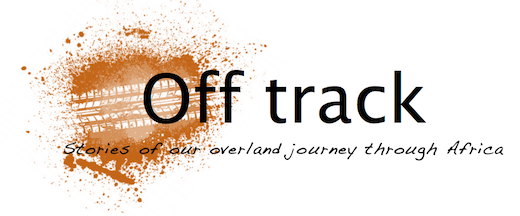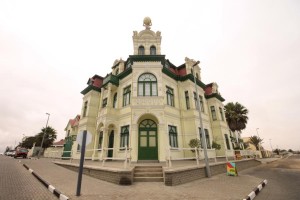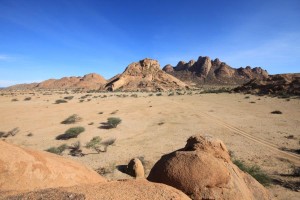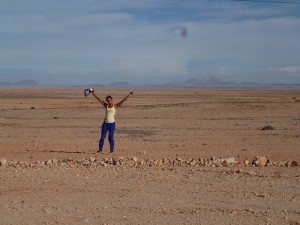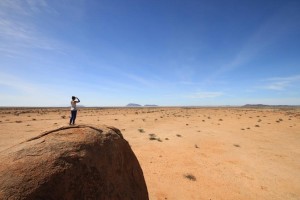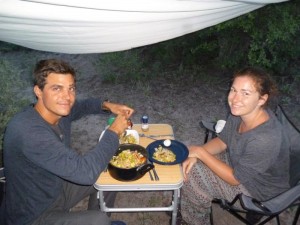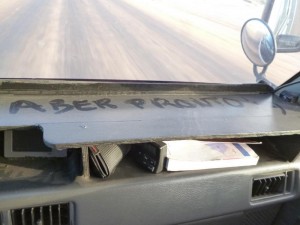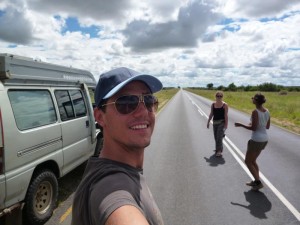The attack of the Tsetse flies and other stories
Hello again everybody! Sorry it took awhile before you heard from us but we have been pretty preoccupied with everything between enjoying tear-bringing views and surviving desert drives. I’ll tell you all about it in a shortlist of events happening in the past few weeks.
Just a short recap of our whereabouts past weeks: after Malawi we went to Zambia, where we visited the metropole Lusaka, the famous Victoria falls and did some very exciting and bloody rafting on the Zambezi river. And a special highlight in Zambia: picking up Amelie, Cornelius’ cousin, from the Airport, who is now travelling with us for 3,5 weeks. It is great to have her here and it is nice to have a change of company for a while 🙂
After Zambia we headed to Botswana, where we visited the Okavango Delta and Chobe National Park, which boasts the world’s largest elephant population. Now we are in Swakopmund, Namibia, and plan to go to Sossusvlei tomorrow. So, back to our personal pick of events.
The scariest event: the Tsetse fly attack in Kafue National Park
That morning we set sail to the national park. Sebastian, a German NGO worker based in Lusaka, had told us to ‘absolutely, most definitely visit Kafue’ because there were supposed to be ‘loads and loads of animals, just along the main road so no entrance fees to be paid.’ Sounded good. We planned to drive up and down the main road and camp in the wild somewhere on a side road.
The first 80 km through the park turned out to be a total disappointment. Sebastian got our hopes up very high, but all we saw were a couple of zebras, two elephants from far away and a glimpse of a hippo in the river. A very meagre show. We decided to drive back and find a spot to setup our camp.
We found a quiet parallel dirt road and drove two, three kilometres into the forest. When it was time for a toilet break we crouched down, each on one side of the car. Just after I pulled my pants down, it happened. I heard zooming around my head and saw flies in front of me. It was a different kind of zooming than the normal housefly produces: more aggressive, louder. ‘Ouch, shit!’ I felt a nasty sting in my right buttock and I slapped the fly away. ‘shit, again!’ and swept the fly from my lower back and rubbing the painful spot. From the slapping and yelling coming from the other side of the car I could tell that the flies had also discovered Cornelius. The little suckers aimed and were persistent, their number growing and growing. The noise got so loud we could hardly hear each other. ‘Conny! Just pull your pants up and get in the car. Now!’ and slightly panicked we drove off.
Through the open windows the flies kept coming and coming. And they were persistent! Dozens were sitting on the window, waiting for their turn to feast on our flesh. We tried to fan them out of the car, but no success. More stinging, more panic.
We needed a change of strategy. No panicking and screaming anymore. Now it was our turn! We stopped the car, closed the windows and the Conny & Githa death squad kicked off. They had such hard skins that just pressing them on the window didn’t do the trick: you really had to take the fly between two fingers under your cloth and pinch with all your strength until you heard it cracking. And even then, they sometimes recovered and attacked again.
We hit, squeezed, pinched and smacked until finally, after 50 minutes, the floor of the car was covered in dead brown-and-grey winged bullies. We sighed in relief and turned the car around to find a fly-free area.
On the way back we were lucky though: we saw a cheetah (which is very rare) crossing the street and crouching besides the road, watching us watching him. This grand finale made our visit to Kafue definitely worthwhile. Afterwards Wikipedia told us that these tough-pantsered little terrorists were Tsetse flies. They can infect you with sleeping disease.
The bloodiest event: white water rafting on the Zambezi

To give Amelie the proper introduction to Africa, we thought a rafting trip on the Zambezi river would be a great idea. That morning we were picked up in our hostel by the organisation and after an extensive explanation on how to get back in the boat when you fall out and how to dodge crocodiles, we kicked off the raft from shore. Rafting on the Zambezi was amazing: mastering rapids between level 3 and 5 and between rapids enjoying the vast rock formations of the gorges and swimming in the warm river. The organisation also spiced up the trip with some ‘extra curricular’ items such as cliff jumping and sliding of rocks.
At one point the guides had the excellent idea to slide off some cliffs in a train setting. Obviously Conny was up for another adventure and took the middle position, in which he was sandwiched by the two guides. The rest of the rafters stayed behind and watched, being unsure if this was such a good idea. The 3 people train kicked off, swirled down the rocks and when they hit the water, water splashed, heads collided and the train got derailed. Laughter and relieved faces everywhere, when Connies face appeared, his face was covered in blood. The skin over his left eyebrow had teared during the head-to-head confrontation. It was a frightening sight, this 5 cm cut, and when we got back into the boat to finish the last rapids, the feeling of excitement was replaced by silence and apprehension.
After the trip we went to the local dispensary where a young doctor stitched Conny up. He was assisted by a stern looking, heavyweight nurse in white dress and white hospital shoes and dictated the medication he should take. ‘Antibiotics were especially important’, she stated while preparing a nice pill-and-cream cocktail, ‘because there are all kinds of germs and bacteria in that Zambezi’. Conny ‘Waldorf/geitenwol’ Huber initially didn’t want to take any pills. When she heard his response, her lips pressed into a thin line, her jawline tightened. She heaved her large body from the seat, marched into the examination room en planted herself in front of him. She looked as strict as only seen on Surinamese women trying to discipline a misbehaving child. She placed one hand on her hip, patted Connies cheek with the palm of the other and said ‘boy, you WILL take your pills.’ And Conny took his pills. He is okay now, in a Frankenstein-like way.
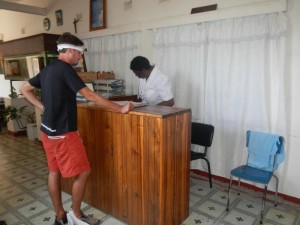
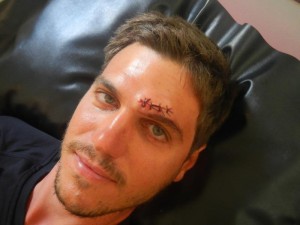
The most expensive event: getting a wide angle
I was bummed out by my camera. I have had this digital mirror reflex camera for years and I was always happy with the pictures it produced, but after it ate dust in the Simien mountains and I had it cleaned, it wasn’t the same as before. It never managed to get it back to its old self. Until I visited mister Nitsche-Reiter in Windhoek.
While driving to Namibia I had looked at pictures in the guide book of what I imagined should be one of the most beautiful countries in the world. How could we travel here and not being able to make good pictures myself? I felt desperation sneaking up on me and decided to have my camera checked and if it was still okay, give myself a wide angle objective (suitable for landscapes) as a very, very early birthday present. Mister Nitsche-Reiter was a specialist and, lucky for me, he was German. So with a precision only seen in Germans he adjusted settings, checked body and lens, gave me advise and sold me a powerful wide angle objective at a reasonable price. And my investment paid off: not only did my new wide angled friend lived fully up to expectations, also my camera-old lens combination was rocking it again. Thanks to the able help of the German-Windhoekian camera whisperer!
The most impressive event: laying eyes on the endless Namib Desert in Damaraland
After visiting the capital Windhoek we drove into one of the widest, most deserted areas of Namibia: Damaraland. This area is named after the indigenous people that originally reside here. There are not many inhabitants though, not in Damaraland, nor in Namibia as a whole. With 2,1 million people and ca. 2 persons per square kilometres, Namibia is among countries with the lowest people density in the world. On top of that, urbanisation has also reached Damaraland, resulting in us only seeing a handful of people during two days.
We drove to Spitzkoppe, an impressive inselberg, or island hill, surrounded by vast lakes of emptiness and sand. We had the intention of visiting the hills and sleeping at the campsite. Upon arrival we learned that the Namibian government ‘conveniently’ placed a fence around mountain and camping, so that they could ask enormous entrance fees for both gigs. We didn’t manage to bargain a discount (‘no madam, if we do that, or if our boss allows that, he will get big big problems with the bigger bosses! No discount.’), and asked if wild camping was allowed. Eyebrows were raised in confusion. ‘Yes, but…this is desert. You sure about that? But…You will have no facilities.’ We closed the door, replied ‘yes, we have anything we need,’ turned around and found a beautiful spot at the other side of the mountain. We setup camp on the foot of a smaller hill with a stunning sunset view over the Spitskoppe hills- When we climbed to a high point and first layes eyes on the vast wideness of the Namib Desert in Damaraland. I thought this was one of the most beautiful landscapes I have ever seen. It reminded me a bit of the Wadi Rum in Jordan. A great camping spot and dazzling views without paying a penny, we loved it!
The most unsatisfactory event: getting stuck, and again, and again, in the Namib desert sand
After Spitzkoppe we wanted to drive to Twyfelfontein, an Unesco world heritage sight. But none of us looked on the map before taking off and like three zombies, we just followed the instructions of the navigation. The road got dustier and softer, the car got more instable and swayed through the deep sand. We switched from 2WD to 4WD, then to low gear 4WD but it wasn’t enough: we got stuck, the wheels buried in the hot sand.
We got the shovel out and prepared for zealous labour: it was 1:30 pm, the sun was burning and the sand was deep. Twisted enough, Conny sat behind the wheel and Amelie and I took turns shovelling (how did this casting happen?!). After the first excitement of getting loose, we got stuck again. So more shovelling. And then we got stuck again, and again. More shovelling, more sweating, Conny giving instructions from the window casually. After reaching firm ground we sat in the car relieved but we decided to turn around because we didn’t want to risk getting stuck beyond the point that we couldn’t get out by ourselves and had to spend the night there in the desert with wild zebras (and probably lions) running around and zero cars or people to be found for help.
So that day brought us two very unsatisfactory events: 1) no Twyfelfontein and 2) Amelie and I exhausted, covered in sweat, almost dehydrated and Cornelius nonchalantly commenting from the front seat ‘well, that wasn’t so bad, was it?’
The most frustrating event (for Conny, that means): trying to get rid of the sand
Those of you who have driven in a desert before know the phenomenon: the sand comes from everywhere and settles everywhere until there is not one dust free spot. Mouth and ears included. Also when you turn on the ventilation system, the first few seconds feel as if someone who has his hands full of sand, holds them into a cup before your face and blows the whole lot into your eyes.
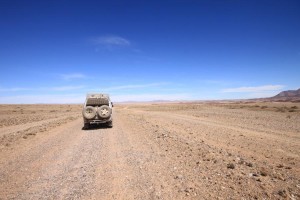
So after our desert adventures Conny, who cleans far more than I do, couldn’t wait to start sweeping (just got to love that man!). Need I say more?
With the bus clean as a whistle and we are taking off to Sossusvlei tomorrow, while Amelie relives her adrenaline shot she got while diving the Namibian sky!
